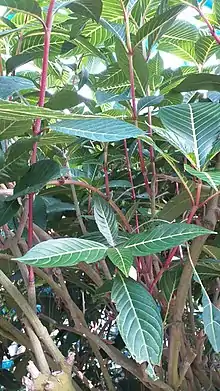| Sanchezia | |
|---|---|
 | |
| Sanchezia speciosa inflorescence | |
| Scientific classification | |
| Kingdom: | Plantae |
| Clade: | Tracheophytes |
| Clade: | Angiosperms |
| Clade: | Eudicots |
| Clade: | Asterids |
| Order: | Lamiales |
| Family: | Acanthaceae |
| Subfamily: | Acanthoideae |
| Tribe: | Ruellieae |
| Genus: | Sanchezia Ruiz & Pav. |
| Species | |
|
20-50, see text | |
.jpg.webp)


Sanchezia is a genus of the plant family Acanthaceae. It is estimated to contain about 20 to 50 species. Members of this genus are shrubs, rarely small trees or herbs, occurring in the lowlands of tropical South and Central America. A close relative is Suessenguthia, which looks quite similar.[1]
Because they have large, colorful bracts and flowers, and sometimes even colorful leaves, several species are cultivated as ornamental plants throughout the tropics and in botanical gardens of temperate areas. Examples for species well known from cultivation are S. nobilis, S. parvibracteata and S. speciosa. In some areas, ornamental species have become problematic as invasive weeds. On the other hand, S. lampra from Ecuador is almost extinct.
Sanchezia is named for José Sánchez, a nineteenth-century professor of botany at Cádiz, Spain.[2]
Selected species
- Sanchezia lampra
- Sanchezia ovata Ruiz & Pav.
- Sanchezia parvibracteata
- Sanchezia parviflora
- Sanchezia peruviana
- Sanchezia putumayensis
- Sanchezia sericea
- Sanchezia speciosa Leonard[3]
- Sanchezia nobilis (zh) Hook.f.[3]
- Sanchezia oblonga (wikispecies:Sanchezia oblonga)[4]
Footnotes
- ↑ Leonard & Smith (1964)
- ↑ Clay et al. (1987): p.242
- 1 2 John H. Wiersema [in Spanish]; Blanca León (20 March 2013). World Economic Plants: A Standard Reference, Second Edition. CRC Press. ISBN 978-1-4665-7681-0.: 612
- ↑ "33010". Germplasm Resources Information Network. Agricultural Research Service, United States Department of Agriculture.